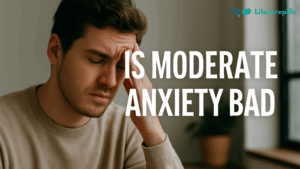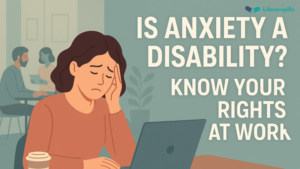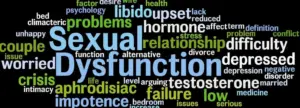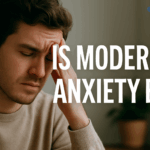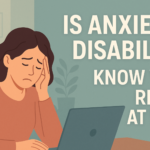Introduction
Anxiety disorders affiliate with some of the world’s highest prevalence of mental health disorders. People across the globe deal with anxiety through uncontrollable worry and nervousness that controls their lives. Checking the evolution of your anxiety makes it possible to identify diseases before they become serious. Watching for anxiety signs helps you take control of your symptoms from the beginning. Learning about these anxiety development phases helps you take appropriate steps at the right time to live better. Learn 7 Stages of Anxiety disorder.
Understanding Anxiety as a Spectrum
The Natural Role of Anxiety
Anxiety, at its core, is not a villain. It’s evolution’s way of keeping humans alert, alive, and away from saber-toothed tigers—or modern-day equivalents like missed deadlines and awkward social encounters. It’s an internal warning system meant to prepare the body for perceived threats.
When Normal Worry Becomes Dysfunctional : 7 Stages of Anxiety disorder
The line between useful concern and disruptive anxiety is fine but crucial. When the “what ifs” and imagined catastrophes refuse to quiet down—even in the absence of real danger—that’s when anxiety shifts from helpful to harmful.

Stage One: Generalized Unease / Early Stage Symptoms
Recognizing Initial Signs of Anxiety
Early signs often look like everyday worries but tend to stick around longer. Think nervousness, restlessness, or mild worry that pops up suddenly. Sometimes, you might feel tense without knowing why. It’s different from normal anxiety, which usually passes quickly. Early signs may also include difficulty sleeping or feeling more irritable than usual.
Subtle Psychological Whispers
The alarm starts as a faint noise rather than loud shrieks. Your moods become unstable and you respond strongly to stress. Your mind scans constantly for threats, but they’re intangible. It feels like waiting for something bad, without knowing what or why.
Minor Behavioral Shifts
You might start canceling plans or triple-checking locks. Sleep becomes lighter. Your phone becomes a distraction rather than a tool. These aren’t major disruptions—yet—but they signal the anxiety engine is warming up.
Triggers and Contributing Factors
Certain things can trigger early anxiety. Common triggers include stressful life events, trauma, or family history. Your daily routine, environment, and mental health background also play roles. For example, messy work deadlines or family conflicts might spark initial anxiety episodes.
Tips for Early Prevention
Start managing anxiety early with simple steps. Deep breathing and meditation together with mindfulness help minimize tension levels. A healthy lifestyle practice requires regular exercise together with proper sleep hours and limited consumption of caffeine. Symptoms of anxiety that persist need immediate attention from a mental health expert.
Stage Two: Recurring Anxiety Patterns / Moderate Anxiety
Cognitive Loops and Overthinking
Worry becomes a cycle. Thoughts loop endlessly. What if I said the wrong thing? What if something happens to my loved ones? These mental spirals are exhausting. Logic has no real power here—emotion dominates.
Anticipatory Anxiety
Now you’re not just anxious in the moment; you’re anxious before the moment. The fear of fear creeps in. You dread future situations, expecting discomfort, and often feel trapped in “what might go wrong.”
Symptoms and Behavioral Changes
As anxiety grows, physical symptoms become more obvious. You might notice rapid heartbeat, sweating, or fatigue. These feelings happen more often and interfere with daily life. Social outings might become stressful, and work might suffer. You may start avoiding certain situations that make you anxious.
Common Co-occurring Conditions
Moderate anxiety often links with other issues like depression or panic attacks. Sometimes, people feel overwhelmed and withdraw from friends or family. Anxiety might also lead to difficulty concentrating or sleeping enough. Getting a full diagnosis involves looking for these related conditions.
Strategies to Halt Progression
You can slow down anxiety’s growth with various strategies. Through CBT treatment, people can achieve new mental patterns for their well-being. Support groups help members receive both comfort and practical advice. Lifestyle changes like regular exercise and a balanced diet support emotional health. Early intervention makes a big difference.
Stage Three: Physical Manifestations
Nervous System Overload
Anxiety isn’t just mental—it’s intensely physical. Your body stays in “fight or flight” mode. Heart pounding, muscles tensing, palms sweating. The sympathetic nervous system takes over, leaving you wired and weary.
Psychosomatic Symptoms
You may feel dizzy without standing up. Experience stomach cramps without eating. Tension headaches that linger. These symptoms often get misdiagnosed as purely physical, but they’re the body’s echo of a distressed mind.
Stage Four: Lifestyle Disruption
Avoidance and Withdrawal
As anxiety grows, life shrinks. You might skip events, decline opportunities, stop traveling, or even avoid talking on the phone. The walls start closing in as the world feels more dangerous, unpredictable, and overwhelming.
Sleep and Appetite Disturbance
Insomnia becomes common—either falling asleep is hard or waking at 3 AM with a racing mind becomes the norm. Food can lose its appeal or become a source of comfort. Both extremes wreak havoc on body and mood.
Stage Five: Severe Anxiety and Panic Attacks
Recognizing Severe Symptoms
The effects of severe anxiety generate strong physical reactions in the body. The characteristic symptoms of severe anxiety include chest pain in combination with dizziness and trembling. You may experience such intense physical feelings that you think you are going to fail to control yourself or something dreadful is approaching. The sensation of panic normally makes this phase extremely frightening.
Panic Attacks and Chronic Fear
People who live with panic attacks face sudden unexpected waves of fear that occur whenever they appear. Chest tightens. Breathing shortens. Thoughts race toward doom. These episodes are terrifying and often misunderstood as heart attacks or serious illnesses.
Emergency Intervention and Treatment Options
Seek emergency assistance by calling services as chest pain exists with unbearable symptoms. Brief breathing exercises together with grounding techniques reduce suffering temporarily. To achieve relief people sometimes need medical help which includes antidepressant drugs and anti-anxiety medications. The main strategy for long-term management includes therapy treatment along with lifestyle adjustments.
Stage Six: Chronic Anxiety and Compounding Mental Health Issues
Persistent Symptoms and Long-Term Effects
Chronic anxiety means your feelings continue for long periods reaching up to several months and years. Your anxiety problems create harm to many aspects including your family bonds and your professional life together with your physical state. You may experience extreme fatigue together with irritability and deep hopelessness. The absence of proper treatment for persistent anxiety will increase the probability of developing other mental health conditions including depression.
Depression and Emotional Exhaustion
Depression develops as a result of continuous worrying. Hopelessness sets in. The combination of numbness and disconnection along with extreme exhaustion takes hold of your being. One loses their ability to experience happiness regarding anything. Various forms of depression join with anxiety to create a continuous destructive cycle between the two conditions.
Substance Misuse and Escapism
People attempt to mitigate their chronic anxiety through alcohol use together with drugs and excessive gaming as well as various coping behaviors. These temporary relief strategies usually create more problems than they solve because they create dependencies that cause shame to arise.
Long-Term Management Approaches
The treatment of long-term anxiety needs either ongoing medication and therapeutic care or natural remedies or pharmacological therapy. Creating routines along with coping strategies will simplify your normal daily activities. The stability of your mental condition depends heavily on maintaining mindfulness practice together with scheduled visits with mental healthcare professionals.
Stage Seven: Identity Enmeshment
When Anxiety Becomes Self-Image
At the furthest extreme, anxiety becomes part of your identity. You stop saying “I have anxiety” and start thinking “I am anxious.” It colors every interaction, decision, and aspiration. It becomes the lens through which you view the world—and yourself.
Losing Sight of “Normal”
You forget what calm feels like. Even on good days, you wait for the shoe to drop. Trust in your own mind erodes. You may assume this state of tension is permanent, forgetting that a different existence is possible.
Pathways to Recovery and Stability
Recognition and Acceptance
Recovery begins with acknowledgment. Not denial. Not minimization. A simple, powerful truth: “This is anxiety, and it’s affecting me.” That awareness breaks the illusion of normalcy around dysfunction.
Professional Interventions
Cognitive-behavioral therapy (CBT) together with EMDR or exposure therapy creates significant changes but therapy itself transforms people. The brain chemistry of severe symptoms can be regulated through SSRIs or anti-anxiety agents. Getting assistance through organized therapies does not indicate weakness.
Holistic Lifestyle Adjustments
The practice of exercise together with mindfulness, along with journaling and deep breathing strategies, actually works as a proven tool for nervous system recovery. These instruments help people restore control over their nervous system functions. Daily interactions with sunlight, together with routine development and stimulant reduction, help the body and mind maintain equilibrium in the long term.
The Importance of Community and Support
Isolation deepens anxiety. Support groups and loved ones on online forums provide everyday sharing, which reduces the impact of your difficulties. Participating in a community lets you realize you never face recovery alone while ensuring you will discover the correct path forward.
Recognizing Achievements and Ongoing Challenges
Complete removal of anxiety symptoms is not necessary to achieve recovery goals. Recovery has two main objectives, which are the management of symptoms and the prevention of anxiety recurrence. The achievement of progress results in both greater self-control and decreased panic attacks. Regular checking of your vulnerability is needed due to occasional setbacks occurring in recovery.
Preventative Measures and Lifestyle Adjustments
Stress decreases when you follow a regular habit of doing physical activities and eating healthily while getting enough rest at night. Having good connections with people makes them your main helpers during hard times. Practicing new coping methods reduces anxiety and builds your resistance to any setbacks.
Resources for Continued Support
People rely on group support and counseling while medical apps help patients recover. Making a custom plan for relapse prevention prepares you properly. Consider yourself safe to ask for assistance whenever you want it.
Conclusion: Reclaiming Peace from the Spiral
Anxiety develops quietly but will transform into severe emotional turmoil without proper attention. The good news? You can change the story. You can treat every stage of your struggle as an evaluation point not as a final destination. You can escape anxiety by getting proper assistance and helpful support.
FAQs Section
Q1. What are the first signs of anxiety?
A: Small anxiety symptoms often start weak and may evade your notice at the beginning. You will likely experience more tension in your body while your concentration weakens plus your brain focuses on potential dangers. Your initial anxiety symptoms include difficulty sleeping, restlessness and persistent mental loops.
Q2. Can anxiety go away on its own?
A: When anxiety stems from a temporary issue it can disappear by itself. Contact professional help when anxiety symptoms do not clear or intensify. Different treatment methods combined with better living habits and personal care help manage the condition.
Q3. When should I see a therapist for anxiety?
A: When anxiety affects mental health, assistance arises when anxiety comes between you and your everyday life and professional responsibilities. Getting professional support at the onset of anxiety symptoms increases the pace at which your condition improves.
Q4. What are the 7 stages of anxiety?
A: The 7 stages include:
- Subtle Worry
- Lingering Unease
- Overthinking
- Physical Symptoms
- Avoidance Behavior
- Daily Disruption
- Emotional Breaking Point
Discovering anxiety stages at their early stages allows you to control your anxiety effectively.
Q5. Is anxiety curable or just manageable?
A: Anxiety is highly treatable. People can either get better from anxiety or develop solid coping methods that make the condition unobtrusive. Each person can benefit from using various mental health treatments together with mindfulness practice and medicine as well as support networks.


